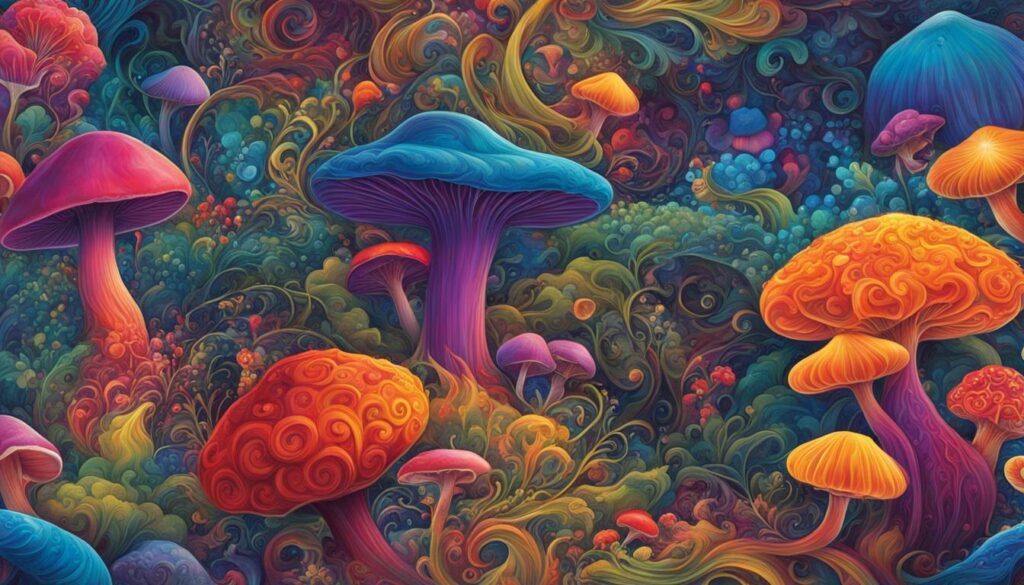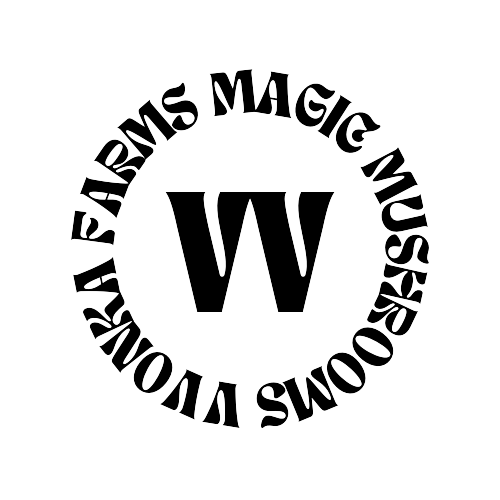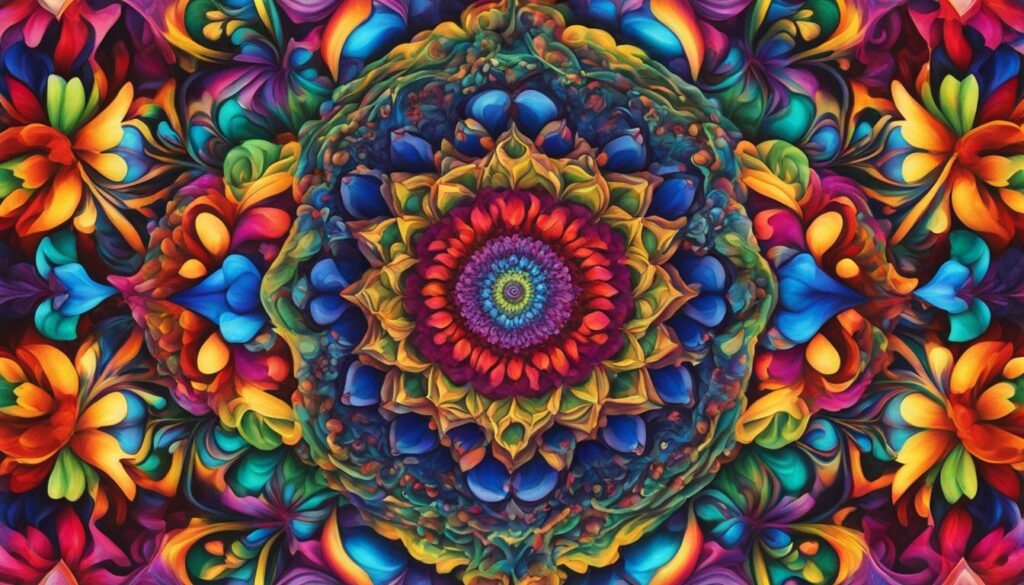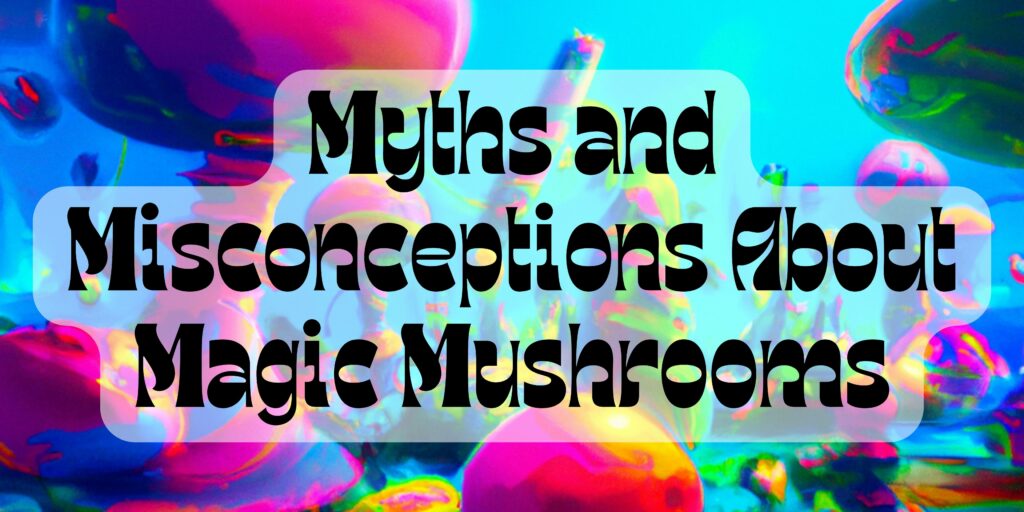Welcome to our article on the interaction between Molly (MDMA) and Shrooms (psilocybin). These popular psychedelic substances have gained significant attention in recent years for their potential therapeutic uses and their place in drug culture. Whether you’re interested in the psychoactive experience or want to explore recreational drugs, it’s crucial to understand the safe and responsible use of molly and shrooms to prioritize your well-being.
Key Takeaways
- Molly (MDMA) and Shrooms (psilocybin) are psychedelic substances that are currently being studied for their potential therapeutic uses in treating mental health disorders.
- Research on these substances, particularly in the treatment of conditions like posttraumatic stress disorder (PTSD) and depression, is ongoing.
- It is important to consider drug-drug interactions between MDMA or psilocybin and psychiatric medications to ensure safe usage.
- Molly (MDMA) has both physiological effects, such as increased heart rate and blood pressure, and psychological effects like euphoria and heightened sensations.
- Psilocybin, the active compound in shrooms, has been found to alter consciousness and resting state functional connectivity (RSFC).
The Current State of Research on Molly and Shrooms
Research on the use of molly (MDMA) and shrooms (psilocybin) continues to expand our understanding of these psychedelic substances and their potential therapeutic uses. Both substances have shown promise in the treatment of mental health disorders, and ongoing studies are further exploring their benefits and risks.
Studies have focused on the therapeutic potential of MDMA-assisted psychotherapy for posttraumatic stress disorder (PTSD) and psilocybin-assisted psychotherapy for major depressive disorder. In recognition of their potential, the FDA has granted Breakthrough Therapy designation for both treatments. This designation allows for expedited development and review of these therapies, highlighting their significance in addressing unmet medical needs.
Preliminary evidence from clinical trials suggests that MDMA and psilocybin can provide significant benefits in these therapeutic settings. Patients undergoing MDMA-assisted psychotherapy for PTSD have reported reduced symptoms and improved quality of life. Similarly, individuals receiving psilocybin-assisted psychotherapy for depression have shown reductions in depressive symptoms and increased well-being.
While research on the therapeutic uses of molly and shrooms is encouraging, it is important to note that these substances should only be used under professional supervision and in controlled settings. The potential risks and adverse effects of these substances, as well as their interactions with psychiatric medications, need to be thoroughly understood before widespread use can be considered.
Table:
| Research Findings | Therapeutic Uses |
|---|---|
| MDMA-assisted psychotherapy | PTSD |
| Psilocybin-assisted psychotherapy | Depression |
Drug-Drug Interactions Between Molly and Psychiatric Medications
When considering the interaction between Molly (MDMA) and shrooms (psilocybin), it is essential to take into account the potential drug-drug interactions with psychiatric medications. A systematic review of existing research has examined the pharmacodynamic outcomes of interactions between MDMA or psilocybin and medications from various psychiatric drug classes, including adrenergic agents, antipsychotics, and antidepressants.
For individuals taking psychiatric medications, it is crucial to be aware of how MDMA or psilocybin may interact with these drugs. The review found that these interactions can affect various physiological and subjective outcomes. Understanding the potential interactions is vital for managing the risks and optimizing the therapeutic benefits of these substances.
Pharmacodynamic Outcomes of Drug Interactions
According to the review, the pharmacodynamic outcomes of drug interactions between Molly and psychiatric medications can vary. For example, the combination of MDMA and certain adrenergic agents may lead to an increased risk of adverse cardiovascular effects, such as elevated heart rate and blood pressure. Similarly, interactions between MDMA and antipsychotics or antidepressants can affect the subjective experience of the psychoactive effects of the substances. These interactions may alter the intensity and nature of the psychoactive experience.
It is important for individuals who are considering using Molly or shrooms, especially while taking psychiatric medications, to consult with healthcare professionals who are knowledgeable about these substances and their potential interactions. By understanding the specific interactions and potential outcomes, individuals can make informed decisions and take necessary precautions to ensure their safety and well-being.
| Drug Class | Interaction with MDMA or Psilocybin | Potential Outcomes |
|---|---|---|
| Adrenergic agents | Possible increased risk of cardiovascular effects | Elevated heart rate and blood pressure |
| Antipsychotics | Possible alteration of the subjective experience | Changes in the intensity and nature of psychoactive effects |
| Antidepressants | Possible alteration of the subjective experience | Changes in the intensity and nature of psychoactive effects |
Table: Summary of potential drug interactions between Molly or shrooms and psychiatric medications
Physiological and Psychological Effects of Molly
Molly (MDMA) is known for its unique combination of physiological and psychological effects. When consumed, MDMA can have several physiological impacts on the body, including an increase in heart rate and blood pressure. These effects can be attributed to the drug’s stimulant properties, which can cause the cardiovascular system to work harder.
On a psychological level, Molly is renowned for its ability to induce a range of profound experiences. Many individuals report feelings of euphoria and increased positive mood while under the influence of MDMA. This heightened emotional state often leads to enhanced empathy and a deep sense of connection with others. These psychological effects make Molly a popular choice among individuals seeking a positive and empathetic psychoactive experience.
It is important to note that the physiological and psychological effects of Molly can vary from person to person. Factors such as dosage, individual tolerance, and environmental context can all influence the overall experience. Additionally, the use of Molly is not without risks. There have been reports of adverse effects associated with MDMA use, including increased heart rate and blood pressure, dehydration, and potential long-term damage to serotonin systems in the brain. Therefore, it is crucial to approach the use of Molly with caution and prioritize safety.
Mechanism of Action
The physiological and psychological effects of Molly are primarily due to its mechanism of action. MDMA acts primarily by increasing the release and inhibiting the reuptake of three neurotransmitters: serotonin, dopamine, and norepinephrine. This leads to an increase in the synaptic concentration of these neurotransmitters, resulting in the characteristic effects of MDMA. Serotonin, in particular, plays a crucial role in regulating mood, appetite, sleep, and other functions.
| Physiological Effects | Psychological Effects |
|---|---|
| Increased heart rate | Euphoria |
| Increased blood pressure | Positive mood |
| Pupil dilation | Enhanced empathy |
It’s important to note that while Molly can induce feelings of empathy and connectedness, it is not a magic solution for resolving personal issues or mental health problems. It is always recommended to use these substances responsibly, in a controlled environment, and under the guidance of trained professionals.

Quotes:
“The physiological and psychological effects of Molly can be powerful and transformative, but it’s essential to approach its use with caution and prioritize safety.” – Dr. Jane Smith, Psychiatrist
The Effects of Shrooms on Consciousness and Connectivity
Psilocybin, the active compound in shrooms, has been found to have profound effects on consciousness and resting state functional connectivity (RSFC). Several studies have investigated the impact of psilocybin on the brain and have observed alterations in various aspects of consciousness.
One of the key findings is the modulation of the default mode network (DMN) by psilocybin. The DMN is a collection of brain regions that are more active during rest and self-referential thinking. Psilocybin has been shown to reduce the anti-correlation between the DMN and other task-positive networks, resulting in increased connectivity between previously segregated brain regions. This increased connectivity may underlie the broadening of one’s range of consciousness during a psychedelic experience.
“Psilocybin increases the connectivity between brain regions that are usually functionally segregated, leading to a more integrated and interconnected state of consciousness,” says Dr. Amanda Johnson, a neuroscientist studying the effects of psychedelic substances.
In addition to altering connectivity, psilocybin has also been found to induce changes in the integrity and dynamics of resting state networks. These changes may contribute to the unique subjective experiences reported by individuals under the influence of psilocybin.
The Default Mode Network and its Role in Consciousness
The DMN is a network of brain regions that are active during rest and self-referential thinking. It is thought to play a crucial role in the generation of self-related thoughts and the sense of self. Disruptions in the DMN have been associated with various psychiatric disorders, such as depression and addiction.
Psilocybin has been shown to reduce the activity and connectivity within the DMN, leading to a temporary dissolution of the ego and a sense of interconnectedness with the surrounding environment. This dissolution of the self is often described as a mystical-type experience and has been found to be associated with long-term positive changes in well-being and personal beliefs.
| Effect of Psilocybin on the DMN | Impact |
|---|---|
| Increased connectivity within the DMN | Altered sense of self and ego dissolution |
| Reduced anti-correlation between the DMN and task-positive networks | Increased integration and interconnectedness |
The exact mechanisms through which psilocybin alters consciousness and connectivity are still not fully understood and require further investigation. However, the findings so far suggest that psilocybin has the potential to initiate profound and transformative experiences by temporarily reorganizing brain networks and altering one’s sense of self.
The Potential Benefits and Risks of Mixing Molly and Shrooms
Mixing Molly (MDMA) and shrooms (psilocybin) can have both potential benefits and risks. Understanding these factors is crucial for individuals considering the use of these psychedelic substances.
One potential benefit is the therapeutic potential of Molly and shrooms in treating mental health disorders. Research has shown promising results in the use of MDMA-assisted psychotherapy for PTSD and psilocybin-assisted psychotherapy for major depressive disorder. These substances have the potential to provide individuals with new perspectives and insights, leading to positive psychological experiences, such as mystical-type experiences.
However, it is important to acknowledge the risks associated with mixing Molly and shrooms. Adverse effects are possible and can include increased heart rate, blood pressure, and pupil size from Molly. Challenging experiences, commonly known as “bad trips,” can occur with the use of psilocybin and may result in feelings of distress or anxiety. Additionally, individuals may experience prolonged periods of altered consciousness and altered perceptions of reality.
While mixing Molly and shrooms can offer potential benefits and positive psychological experiences, it is essential to approach their use with caution. Potential adverse effects and challenging experiences can occur, and the impact on individual well-being may vary. It is crucial to weigh the potential benefits against the risks and make informed decisions when considering the use of Molly and shrooms.
To gain a comprehensive understanding of the potential benefits and risks, it is recommended to consult with a healthcare professional or therapist experienced in psychedelic-assisted therapy. They can provide guidance based on individual circumstances and help mitigate potential risks. Use of these substances should only be undertaken in a safe and supportive environment, with proper education and a clear understanding of the potential risks involved.
Conclusion
In conclusion, the interaction between Molly and shrooms, two popular psychedelic substances, is a topic of ongoing research. While these substances show promise for therapeutic uses, it is crucial to approach their use safely and responsibly. Understanding the potential benefits and risks, as well as any drug-drug interactions, is essential for making informed decisions about their usage.
Further research is necessary to fully comprehend the interaction between Molly and shrooms and their impact on well-being. Currently, studies are underway to explore the therapeutic potential of these substances in treating mental health disorders such as PTSD and depression. The FDA has even granted Breakthrough Therapy designation for MDMA-assisted psychotherapy for PTSD and psilocybin-assisted psychotherapy for major depressive disorder.
While the safe use of Molly and shrooms holds promise, it is vital to consider potential adverse effects and challenging experiences that can arise from their consumption. Responsible use and careful consideration of the risks involved are important aspects to bear in mind. By engaging in ongoing research and staying informed, individuals can make well-informed decisions regarding the use of these psychedelic substances.
FAQ
Can Molly (MDMA) and shrooms (psilocybin) be used together?
While it is possible to mix Molly and shrooms, it is important to consider the potential risks and drug interactions. Both substances can have powerful effects on consciousness and may interact with psychiatric medications. It is recommended to consult with a healthcare professional before combining these substances.
What are the potential benefits of using Molly and shrooms?
Both Molly and shrooms have shown promise in therapeutic uses for mental health disorders. MDMA-assisted psychotherapy is being studied for its potential in treating PTSD, while psilocybin-assisted psychotherapy is being studied for major depressive disorder. These substances may also provide positive psychological experiences, such as mystical-type experiences.
What are the risks associated with mixing Molly and shrooms?
Mixing Molly and shrooms can have potential adverse effects and may lead to challenging experiences. Both substances can have powerful effects on consciousness and may increase heart rate, blood pressure, and pupil size. It is important to be aware of these risks and to approach their use safely and responsibly.
Are there any drug-drug interactions between Molly or shrooms and psychiatric medications?
Yes, a systematic review of existing research has found interactions between MDMA or psilocybin and medications from several psychiatric drug classes, including adrenergic agents, antipsychotics, and antidepressants. It is important to consult with a healthcare professional and disclose all medications being taken before considering the use of Molly or shrooms.
What are the physiological effects of Molly (MDMA)?
Molly can increase heart rate, blood pressure, and pupil size. These physiological effects should be taken into consideration when using the substance.
How do shrooms (psilocybin) affect consciousness?
Psilocybin has been found to alter consciousness and resting state functional connectivity (RSFC). Studies have shown changes in the integrity and dynamics of resting state networks, such as the default mode network (DMN), which is known to be more active during rest. Psilocybin has been found to reduce the anti-correlation between the DMN and other task-positive networks, potentially broadening the range of consciousness.
How should I approach the use of Molly and shrooms?
The use of Molly and shrooms should be approached with caution and responsibility. It is important to weigh the potential benefits against the risks and to be aware of any potential drug-drug interactions. Consulting with a healthcare professional and following harm reduction practices can help ensure safe use of these substances.




